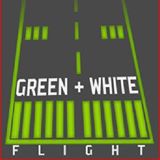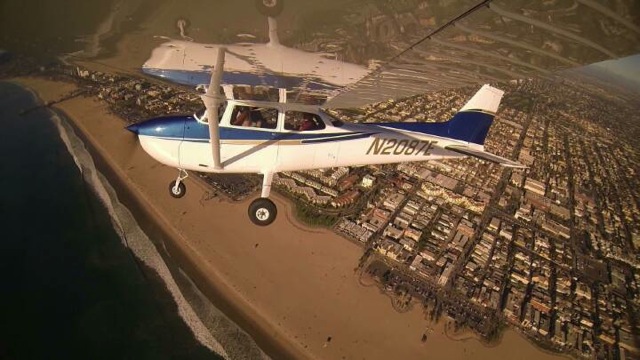 Nicholas Coyle is a 20-year-old senior at the University of North Dakota majoring in Commercial Aviation. He graduates in December and ideally the airlines are in his future. But until then, he wanted to find a cheap way to fly. So he and another student started the Green and White Flight flying club, found an investor to buy an airplane that the club could lease and started operations with 15 members. In this month’s Club Spotlight he shares his experience getting a club off the ground with rates his fellow college students can afford.
Nicholas Coyle is a 20-year-old senior at the University of North Dakota majoring in Commercial Aviation. He graduates in December and ideally the airlines are in his future. But until then, he wanted to find a cheap way to fly. So he and another student started the Green and White Flight flying club, found an investor to buy an airplane that the club could lease and started operations with 15 members. In this month’s Club Spotlight he shares his experience getting a club off the ground with rates his fellow college students can afford.
Name: Green and White Flight
Location: Grand Forks International Airport (KGFK), Grand Forks, ND
Website: https://www.facebook.com/GWFlight
Year formed: 2014
Aircraft: 1978 C-172 Skyhawk ($39/hr)
Rates: Hobbs hours, dry.
Joining fee: No fee
Monthly dues: $65 per month
Membership: 15 (Cap of 15 but may expand)
Scheduler: AircraftClubs.com
 Why did you want to start a flying club?
Why did you want to start a flying club?
I’m still a student at the University of North Dakota. We were running what was a student organization at the time called the UND Flying Club that had a 1955 Tri-Pacer project plane that’s just bare frame right now. I resurrected that club and that led into this.
I wondered, ‘Why isn’t there any flying club up here?’ We’ve got 1,500 students in the (UND) flight school. You’ve got a whole bunch of local area pilots. From what I’m hearing, the closest flying club is a half an hour drive away. There’s nothing out at Grand Forks.
About two years ago we started looking into it. I had never pursued any sort of business or LLCs or an airplane, so I didn’t know much at all. I was very hesitant about doing it. It took me a lot of time to get over the hesitation and fear of it not working out.
In November I got the LLC formed. On February 28 we got approval from the airport authority to begin operations. A month later we secured the plane and we started collecting dues and began full operations the first of April.
What type of aircraft is it?
It’s a 1978 Cessna 172. We worked with an investor. There are two of us that own the LLC and we did all the research and negotiating. We were looking for something in the late ‘70s, four seats, low-time engine, decent avionics, decent interior/exterior. Something that people will enjoy flying and not be embarrassed to take someone with them. This aircraft was in Southern California. It is IFR certified and current with older coms and navs in it and an old Magellan Skynav VFR GPS. We do not have an autopilot.
We flew out there to do the inspection, gave the go ahead and the investor handled the financial side. He transferred the money over and we brought it back up to Grand Forks over a couple days and began operations a couple of weeks later.
How many members do you have?
Just last week we secured our 15th member and we actually have two more that are interested, which could push us to 17. But with one airplane we’re a bit hesitant because of the availability of the aircraft.
Tell me about the members?
We’ve got four or five Grand Forks tower air traffic controllers, there are a couple of CFIs and CFIIs in it. There are a handful of UND aviation students that are in it and then actually this most recent member is an A&P and he flew for Horizon Airlines for a number of years and just moved back.
Is there a joining fee or initiation fee?
No, you pay the $65 a month. If it’s your first time with the club or your first month, you have to get badged with the airport authority. Members are responsible for that cost, which is another $35. So their first month overall ends up being $100—$65 to us and $35 to the airport.
I went through the signatory training so that I can sign off on all the badge applications. Once all the paperwork is done, I send it to the airport and they take care of creating the badge for the member.
We’re having members sign six-month contracts right now just to have a little more stability.
What are your hourly rates?
It’s $39 an hour dry and the reason for that was a lot of the outlying airports around here have gas for almost a buck or more cheaper per gallon, so what I decided was to have dry rates so members can utilize the airplane. A lot of the utilization is guys flying around locally and based on a lot of the local area airports around they’ll top the plane off there and fly it back to Grand Forks.
Our policy is that if you bring it back with at least 30 gallons we’re perfectly fine with that. So they top it off and fly the airplane here and save a few bucks on fuel.
Those rates are really cheap. How did you base your pricing?
I started out looking at other flying clubs and found they were $300 a month or $200 a month or you have to buy in $2,000. I thought there is no way a college student up in this area could afford that, absolutely no way. I decided, what is the next best option?
I looked at an $80,000 plane, a 172. The University of North Dakota’s fleet is mostly brand new 172s. I knew commonality wise, we should stick to a 172.
I got referred to an insurance company. I spoke with them for a rough estimate. I got that number and knew what the hangar fee was. I put together all of our fixed costs, figured out rough estimates for annuals on 172s, so I could come up with a base for my fixed costs each month or thereabout.
I took that and said if I have seven members, this is what I need to charge. If I had 10 members this is what it is. I just created an excel spreadsheet with it. I can just plug numbers in and it will change as we go through.
The hourly rate was a little more of a challenge. I had no idea maintenance-wise how this aircraft would come out. When I was looking at airplanes the biggest thing I considered was how much time was on the engine since a major overhaul, because that was going to be a big determinate for the hourly rate.
It came out to be $15 an hour for the engine reserve. Maintenance was more of a guessing match for me, so I ended doubling it, so $15 an hour for maintenance so now we’re at $30. Per the lease agreement we pay a depreciation value on the airplane, which is where that $9 an hour goes. For every hour the plane is flown $9 goes into the lease for depreciation.
What was it like getting insurance?
We have liability and hull coverage. We got a quote of about $5,000 a year. We planned on that. Once we got the formal insurance quote done on this tail number, the actual insurance came out to be $1,700 a year.
For the check out, we have our application that everyone fills out and then they also fill out a pilot experience form that we send to the insurance company. That way the underwriter knows exactly who is checked out to fly this airplane, their experience, and we agreed that we would do annual recurrent training in the airplane to help bring the rate down.
Are you a 501(c)3?
We operate more like a non-profit. Neither owner pulls anything out of it, everything stays with the club. We don’t have a 501 status. We were going to look at 501(c)7 but it costs $800 to $1,000 to do that. It’s something we’d consider because the bank account accrues money for maintenance reserves and that in turn is considered profit in the business and that gets taxed. I talked to a legal guy and he said the tax bracket we’re going to be in, it’s going to be a very minimal amount and we don’t have to worry too much about taxes.